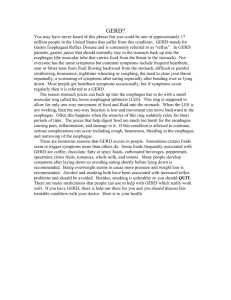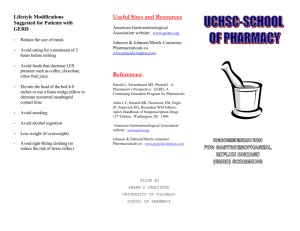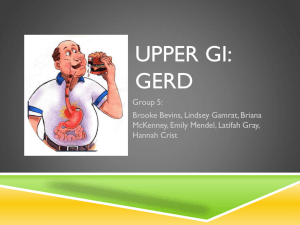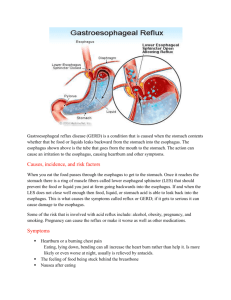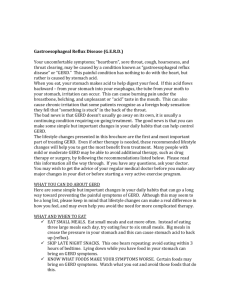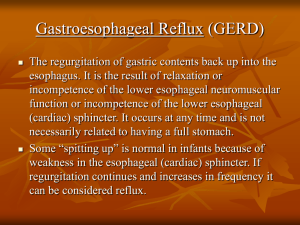Case Study: Gastroesophageal Reflux Disease
advertisement
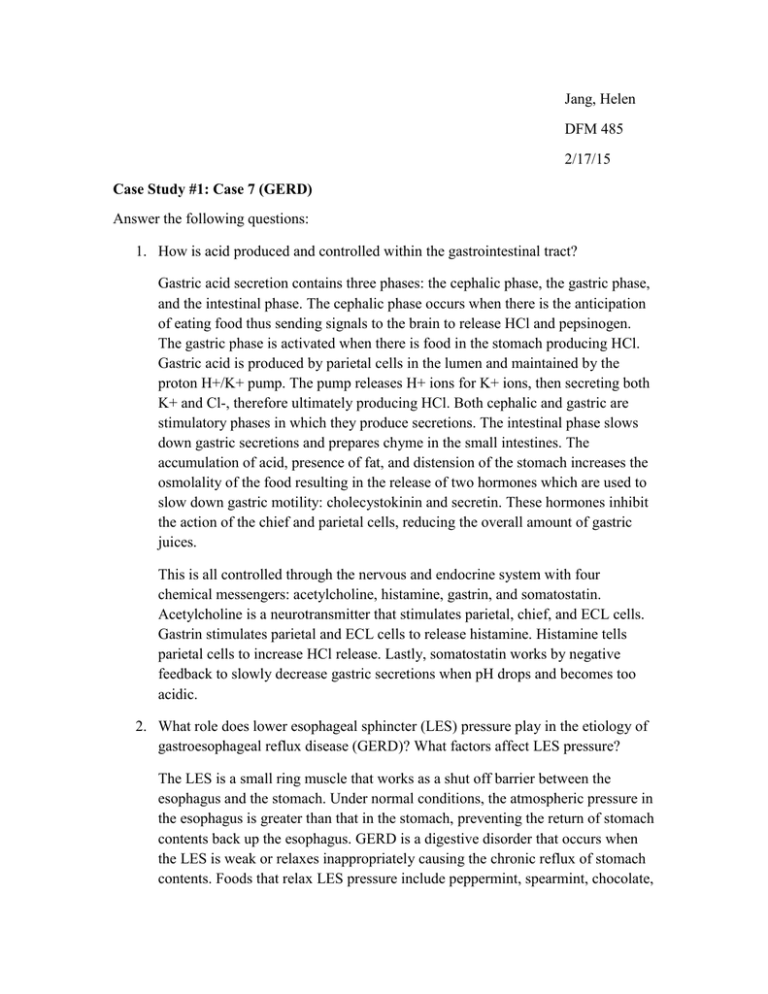
Jang, Helen DFM 485 2/17/15 Case Study #1: Case 7 (GERD) Answer the following questions: 1. How is acid produced and controlled within the gastrointestinal tract? Gastric acid secretion contains three phases: the cephalic phase, the gastric phase, and the intestinal phase. The cephalic phase occurs when there is the anticipation of eating food thus sending signals to the brain to release HCl and pepsinogen. The gastric phase is activated when there is food in the stomach producing HCl. Gastric acid is produced by parietal cells in the lumen and maintained by the proton H+/K+ pump. The pump releases H+ ions for K+ ions, then secreting both K+ and Cl-, therefore ultimately producing HCl. Both cephalic and gastric are stimulatory phases in which they produce secretions. The intestinal phase slows down gastric secretions and prepares chyme in the small intestines. The accumulation of acid, presence of fat, and distension of the stomach increases the osmolality of the food resulting in the release of two hormones which are used to slow down gastric motility: cholecystokinin and secretin. These hormones inhibit the action of the chief and parietal cells, reducing the overall amount of gastric juices. This is all controlled through the nervous and endocrine system with four chemical messengers: acetylcholine, histamine, gastrin, and somatostatin. Acetylcholine is a neurotransmitter that stimulates parietal, chief, and ECL cells. Gastrin stimulates parietal and ECL cells to release histamine. Histamine tells parietal cells to increase HCl release. Lastly, somatostatin works by negative feedback to slowly decrease gastric secretions when pH drops and becomes too acidic. 2. What role does lower esophageal sphincter (LES) pressure play in the etiology of gastroesophageal reflux disease (GERD)? What factors affect LES pressure? The LES is a small ring muscle that works as a shut off barrier between the esophagus and the stomach. Under normal conditions, the atmospheric pressure in the esophagus is greater than that in the stomach, preventing the return of stomach contents back up the esophagus. GERD is a digestive disorder that occurs when the LES is weak or relaxes inappropriately causing the chronic reflux of stomach contents. Foods that relax LES pressure include peppermint, spearmint, chocolate, coffee, alcohol, and foods high in fat. Foods that may increase gastric acid secretions, therefore contributing to GERD, include both regular and decaf coffees, alcohol, and pepper. Avoiding high fats and large meals, losing weight, smoking, and decreasing esophagus irritants such as citrusy foods, spicy foods, and tomato products are some ways to help manage GERD. 3. What are the complications of GERD? Symptoms from GERD are dysphagia, heartburn, increased salivation, and belching. In some cases, GERD can lead to severe pain in the back, neck, or jaw, which can worsen when lying down. Untreated GERD can lead to complications such as impaired swallowing, aspiration of gastric content into the lungs, ulcerations, and constriction of the esophagus. A serious complication from long term or refractory GERD is Barrett’s esophagus, where the tissue lining of the esophagus changes to intestinal tissue. This occurs in approximately 10% of all GERD patients. Having Barrett’s esophagus puts you at a higher risk for adenocarcinoma of the esophagus. 4. The physician biopsied for H. pylori. What is this? H. Pylori, helicobacter pylori, is a type of bacteria that can live in the mucosal layer of the stomach. This bacterium has the ability to break down urea to produce ammonia, which neutralizes acid around the area. It can also cause persistent inflammation and ultimately damage the mucosal lining of the stomach. 5. Identify the patient’s signs and symptoms that could suggest the diagnosis of GERD. The patient is showing symptoms of indigestion and continues to consume high fat meals, which stays in the stomach longer and lowers LES pressure, exacerbating the symptoms of GERD. His recent weight gain and BMI also concludes that he is obese which is highly linked to worsen GERD symptoms. 6. What risk factors does the patient present with that might contribute to his diagnosis? (Be sure to consider lifestyle, medical, and nutritional factors.) The patient does not do much physical activity except play with his children on the weekends. He continues to eat and drink more even after a 35-pound weight gain after his knee surgery a few years ago. His diet recall shows he regularly consumes high fatty meals, which exacerbates his GERD. Overall, his risk factors include complaints of constant indigestion, his weight gain, his overconsumption of foods and alcohol, and his family history of heart disease, which has led to increased distress. 7. Summarize the current nutrition and lifestyle recommendations for nutrition therapy for GERD. To decrease the frequency and volume of the reflux, it is recommended to elevate the head by 30 degrees while laying down, being upright for three to four hours after eating, eating small and frequent meals, losing weight if overweight, separating liquids from meals, and avoiding foods or activities that can cause pain. There are also pharmacological treatments of GERD such as proton pump inhibitors, antacids, histamine receptor antagonists, and prokinetics. Proton pump inhibitors work by inhibiting the proton pump in the parietal cells; therefore, decreasing acid production in the stomach. Antacids work by increasing stomach pH, decreasing acidity. Histamine receptor antagonists also decrease acid secretions. Lastly, prokinetics help control GERD by strengthening the LES, increasing the stomach motility and gastric emptying allowing less time for acid to occur. 8. Calculate the patient’s %UBW and BMI. What does this assessment of weight tell you? In what ways may this contribute to his diagnosis? %UBW: current body weight/ usual body weight x 100 215 / 180 x 100 = 119% BMI: lbs / (in x in) x 703 215 / 4761 x 703 = 31.75 BMI (Obese) Mr. Nelson is 119% of his usual body weight and is currently obese with a BMI of 31.75. People that are obese are more likely to develop GERD and experience worse reflux symptoms. Mr. Nelson’s exacerbation of GERD symptoms can be due to his recent weight gain because BMI is strongly linked to GERD. 9. Calculate energy and protein requirements for Mr. Nelson. How would this recommendation be modified to support a gradual weight loss? Use Mr. Nelson actual current weight and the Mifflin St. Jeor Equation to calculate his energy needs. (Mifflin-St. Jeor = 10W + 6.25H – 5A + 5) Basal Metabolic Rate: 10 (97.7kg) + 6.25 (175.26cm) – 5(48) + 5 = 1837 kcal Total Daily Energy Expenditure: 1937.38 kcal x 1.2 activity factor = 2205 kcal Protein: 0.8g/ kg = 78.17g = 78g protein If the patient tries to do a gradual weight loss of reduction of 250kcals a day, to around 1955kcal, he can lose half a lb a week. If he wants to take it further, he can do a reduction of 500kcals to 1705kcal a day, he can lose one lb a week. Since his usual weight before the 35lb weight gain is 180lbs. He can reach his usual 180 lbs again in 35 weeks, about 9 months, if he reduces his normal calorie intake by 500kcals a day. He can also reach 180 lbs in 75 weeks, about 18 months, if reducing his normal calorie intake by 250kcals a day. 10. Identify pertinent nutrition problems and corresponding nutrition diagnoses and write at least two PES statements for them. Elevated triglycerides levels related to lack of nutrition knowledge and proper diet as evidenced by high cholesterol, low HDL, high LDL, and high triglycerides in laboratory results. Inappropriate weight gain and excessive calorie intake related to physical inactivity and increased calories consumption as evidenced by patient’s 35-pound weight gain and BMI of 31.75. 11. Determine the appropriate intervention for each nutritional diagnosis. Provide and educate patient with proper nutrition knowledge so he can make healthy decisions. Also, educate patient on foods that exacerbates GERD, foods that lessen GERD symptoms, and provide helpful eating strategies to combat reflux. Inform patient the benefits of appropriate weight loss with consideration for his knees and how it will help with GERD symptoms. 12. Using Mr. Nelson’s 24-hour recall, outline any necessary modifications and the rationale for these modifications. Please make sure that all recommendations are appropriate for a patient with GERD. Food Item Crispix Modification Whole grain toast, oatmeal, whole grain cereals Skim milk Good Orange juice Water Rationale Try avoiding processed foods as it stays in the stomach longer; opt for whole grains because it decreases acid secretions Skim milk is a good option for dairy because it is low in fat Avoiding citrus juices can decrease the irritation of the esophagus Food Item Diet Pepsi Modification Water Fried chicken sandwich Grilled chicken with whole grain bread French fries Baked sweet potato Iced tea Water Chips Low sodium crackers Beer Water Fried chicken Lean fish Potato salad Cottage cheese Rationale Try a beverage without carbonation and high acidity because it can cause the stomach to distend from the excess air in sodas High fat foods stay in the stomach longer which can promote more acid production, avoiding them can also help with GERD symptoms; try a leaner protein such as grilled meats High fat foods stay in the stomach longer which can promote more acid production, avoiding them can also help with GERD symptoms; try a starchy vegetable like a baked potato instead Try a beverage without caffeine because it is a major trigger for heartburn High fat foods stay in the stomach longer which can promote more acid production, avoiding them can also help with GERD symptoms; opt for some low sodium crackers Try to avoid alcohol as it lowers LES pressure High fat foods stay in the stomach longer which can promote more acid production, avoiding them can also help with GERD symptoms, try a leaner protein such as fish Potato salads are usually high in fat because of the mayonnaise, they usually contain onions as well which both are triggers of GERD symptoms; try opting for cottage cheese which has similar texture but lower in fat Food Item Green bean casserole Fruit salad Baked beans Milkshake Modification Steamed vegetables medley Rationale Usually, casseroles contains both peppers and onions which can increase acid secretions; try opting for some steamed vegetables instead Try fruits that are not Avoid acidic foods such as citrusy like berries, citrusy fruits as they are a trigger melons, bananas, peaches for heartburn; try some noncitrusy fruits instead Green Beans, Edamame Try to avoid foods that promote gas as it creates more air in the stomach promoting acid reflux; try some starchy vegetables instead Low fat yogurt, Greek Usually, milkshakes are high in yogurt fat, so try to avoid fatty foods as it stays in the stomach longer; try a low fat yogurt instead
